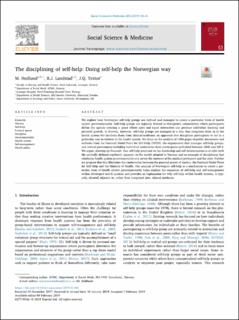| dc.contributor.author | Hedlund, Marianne | |
| dc.contributor.author | Landstad, Bodil | |
| dc.contributor.author | Tritter, Jonathan | |
| dc.date.accessioned | 2020-07-16T13:15:08Z | |
| dc.date.available | 2020-07-16T13:15:08Z | |
| dc.date.created | 2019-04-08T09:23:44Z | |
| dc.date.issued | 2019 | |
| dc.identifier.citation | Social Science and Medicine. 2019, 225, 34-41. | en_US |
| dc.identifier.issn | 0277-9536 | |
| dc.identifier.uri | https://hdl.handle.net/11250/2669302 | |
| dc.description.abstract | We explore how Norwegian self-help groups are defined and managed to create a particular form of health system governmentality. Self-help groups are typically framed as therapeutic communities where participants define the agenda creating a space where open and equal interaction can produce individual learning and personal growth. In Norway, however, self-help groups are managed in a way that integrates them in to the health system but insulates them from clinical medicine; an approach that disciplines participants to act in a particular way in relation to the health system. We draw on the analysis of 1456 pages of public documents and websites from the National Nodal Point for Self-Help (NPSH), the organisation that manages self-help groups, and central government including individual testimonies from participants published between 2006 and 2014. We argue, drawing on Foucault, that self-help premised on lay-leadership and self-determination is at odds with the centrally defined regulation apparent in the model adopted in Norway and an example of disciplining that reinforces health system governmentality and serves the interests of the medical profession and the state. Further we propose that this illustrates the contestation between the pastoral power of medics, the National Nodal Point for Self-Help and the Ministry of Health. Our analysis of Norwegian self-help as a mechanism to create a particular form of health system governmentality helps explain the expansion of self-help and self-management within developed health systems and provides an explanation for why self-help within health systems, is typically situated adjacent to, rather than integrated into, clinical medicine. | en_US |
| dc.language.iso | eng | en_US |
| dc.publisher | Elsevier | en_US |
| dc.rights | Attribution-NonCommercial-NoDerivatives 4.0 Internasjonal | * |
| dc.rights.uri | http://creativecommons.org/licenses/by-nc-nd/4.0/deed.no | * |
| dc.title | The disciplining of self-help: Doing self-help the Norwegian way | en_US |
| dc.type | Peer reviewed | en_US |
| dc.type | Journal article | en_US |
| dc.description.version | publishedVersion | en_US |
| dc.source.pagenumber | 34-41 | en_US |
| dc.source.volume | 225 | en_US |
| dc.source.journal | Social Science and Medicine | en_US |
| dc.identifier.doi | 10.1016/j.socscimed.2019.02.001 | |
| dc.identifier.cristin | 1690741 | |
| dc.description.localcode | This article is available under the Creative Commons CC-BY-NC-ND license and permits non-commercial use of the work as published, without adaptation or alteration provided the work is fully attributed. | en_US |
| cristin.ispublished | true | |
| cristin.fulltext | original | |
| cristin.qualitycode | 2 | |

